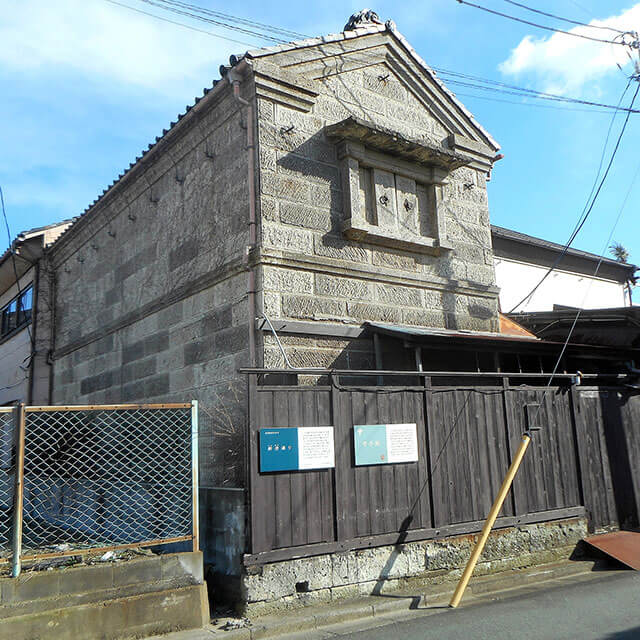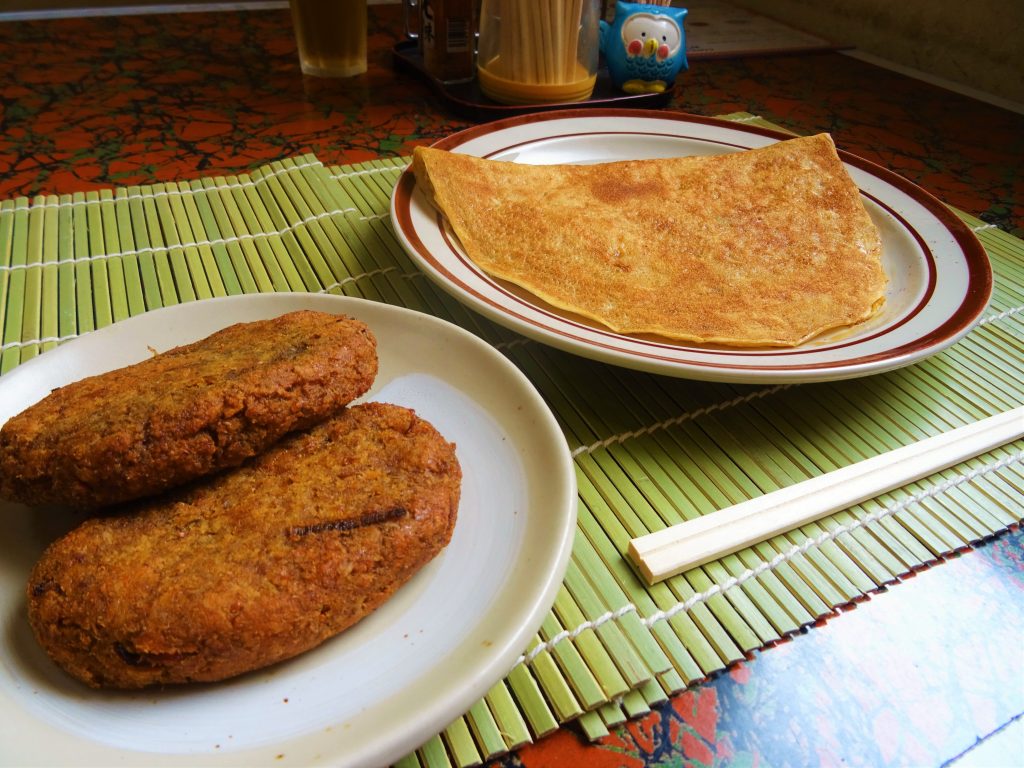History of Gyoda
Japan Heritage Story
Situated at the heart of the Kanto Plain, Gyoda City is famous as the largest producer of tabi socks (traditional Japanese two-toed socks) in Japan and is referred to as the “City of tabi.” Many tabi storehouses called ”tabigura” still stand today, reminding us of the prosperous days of the tabi industry. There are many towns in Japan known for their “kura” or storehouses, where clay-built warehouses called “misegura” that combine shops and residences line the main streets. Unlike these towns, most tabi storehouses in Gyoda are built along back streets, and there are various types of storehouse besides those built from clay, such as those made from stone, brick, mortar, reinforced concrete, and wood. When and how was the “townscape lined with tabi storehouses” created?

Tabi craftsman
How tabi making began
Gyoda City and its surrounding area are located between two large rivers—the Tonegawa River and the Arakawa River. The sandy soil that accumulated when the rivers flooded, an abundant supply of water, and high temperatures in summer were optimum conditions for growing cotton and indigo plant. In modern times, the area flourished through the production of cotton cloth dyed with indigo. Using sewing techniques developed in the city, people then began making tabi socks using this cloth as the raw material.
According to a saying passed down through the years, the origin of Gyoda tabi is said to be “During the Jokyo era (1684 – 1688) when Kameya began specializing in the sale of tabi.” Furthermore, the “Map of Gyoda Town” from around the Kyoho era (1716 – 1735) shows three tabi shops, which indicates tabi production had begun by the early 18th century. Legend says that feudal retainers of the Oshi Domain encouraged women to make tabi during the Kyoho era, and tabi making developed in the area. Gyoda’s tabi became widely known and are even mentioned in the “Picture book of treasures found along the Tokaido and Kisodo Roads” of 1765 as, “The quilted tabi of Oshi is a local specialty.” Tabi could be traded relatively freely as trade guilds did not exist, which was a factor that further boosted tabi production. By the Tenpo era (1830 – 1844), there were as many as 27 tabi shops lining the streets of Gyoda.

Sashi tabi (quilted tabi)
Development of the tabi industry and construction of tabi storehouses
In the modern era, demand increased together with the popularization of tabi. Gyoda’s tabi merchants expanded sales channels by marketing directly to the Tohoku region and Hokkaido, and coupled with production of tabi for military purposes, Gyoda gradually overtook other production sites. Special sewing machines for each work process were introduced to make tabi, and an economic boom related to the Russo-Japanese War triggered a construction boom for tabi factories. Factories were built one after another in the backyards of the merchants’ properties.
As production volume increased, tabi storehouses became necessary to serve as warehouses for storing products until autumn when deliveries went into full swing. In addition to converting existing clay storehouses, many tabi storehouses were built at the very back end of a property.
Gyoda developed around Oshi Castle, which is famous for withstanding Ishida Mitsunari’s attack which aimed to flood the castle. In the early modern period, castles and castle towns underwent redevelopment and taxes were levied according to the frontage of each property. As a result, town lots were formed with streets lined with long rectangular properties having a narrow frontage and extending far back. Gyoda in the modern period served as a post town along the Tatebayashi Road/Nikko Wakiokan Road connecting Kounosu/Fukiage and Tatebayashi, therefore, there was an alley between houses that led to a backyard for taking care of horses. More recently, when people no longer needed to take care of horses, they built tabi factories and storehouses in the unused backyard.
This is how building layouts unique to tabi merchants formed on these rectangular sites, with structures built in a line from the front end, first with a shop and residence, courtyard for guests, factory, tabi storehouse, and yashiki-inari shrine to wish for protection against fire. Measures against fire and cold weather were also taken, such as having a plastered wall only on the north side to protect against the north wind, and having very few windows at the northwest side.
Construction of Gyoda’s tabi storehouses began by the late Edo period if not earlier, and the buildings prevented the great fire of 1846 from spreading. They have unique interior designs with many pillars along the walls to minimize the number of central pillars, which facilitates the handling of products and materials. The floors are also raised for better underfloor ventilation. Prior to the 1900s, purely Japanese-style clay storehouses were built. From around the end of the Meiji period, western-style architecture techniques were introduced in the roof truss structures of clay storehouses, and stone storehouses besides clay ones were also built. In the Taisho period, large-scale tabi storehouses were constructed. And, by the end of the Taisho period, brick storehouses with a steel frame began to appear. In the Showa period, some were made with reinforced concrete, mortar, and wood. Tabi storehouses of varying types and sizes were built in the Showa period before the war. Stone structures became the mainstream after the war due to a shortage of lumber, but construction of tabi storehouses continued until the late 1950s.
Unlike other towns with storehouses, the reason why Gyoda has such a diverse array of tabi storehouses is because new architectural styles were introduced as they continued to be constructed for over a century. The reason behind this is the unique approach taken by Gyoda’s tabi industry, in which the merchants did not merge to become larger companies as production increased, but rather had disciples set up independent shops under the same name. This led to a rise in the number of tabi merchants and storehouses, with more than 200 small and medium-sized companies coexisting at peak periods to form a major production area for tabi.

Post-war stone storehouse (Koushi storehouse)
Japan's No.1 City of Tabi
Gyoda’s tabi merchants expanded sales channels to the Tohoku region and Hokkaido, and rather than distributing through wholesalers, each merchant built an exclusive sales network in each region. For example, Hachinohe was covered by the Rikiya Tabi Shop, Osarizawa Mine was covered by the Dofu Tabi Shop, and so on. The merchants cooperated with each other and gradually expanded sales channels in Japan and abroad.

“Zeri” fried snack (left)Fried snack (right)
During those days, the people of Gyoda, of all ages and gender, devoted their nights and days to tabi making in factories and homes. The sounds of sewing machines echoed throughout the city. The easy-to-eat fried snacks resembling okonomiyaki and “zeri” fried snacks, which is similar to a croquette made with okara (by-product of tofu), became popular among the busy women at the factories who gave every spare moment to making tabi. The fried and “zeri” fried snacks became part of the local culinary culture. Narazuke pickles were also popular as gifts given to customers and became a specialty of Gyoda.
At the height of its prosperity around 1938 to 1939, Gyoda became the leading tabi producer in Japan, boasting around an 80% share of all tabi made in Japan. As the lyrics of Gyoda Ondo go, “Always remember the tabi in Gyoda,” Gyoda and tabi became inseparable, making it “Japan’s No.1 City of Tabi.”
A city of tabi storehouses passing on traditions and developing
Gyoda continues to produce tabi, even today when socks are widely worn. As the leading producer in Japan, Gyoda is delivering new products to Japan and abroad and has become a synonym for tabi.
Around 80 tabi storehouses of various types, which symbolize the prosperity of the tabi industry, are still standing. Together with the sounds of sewing machines floating in the air, they create a charming atmosphere along the back streets of this city of tabi. Re-purposing these storehouses is also adding new excitement to the city.

